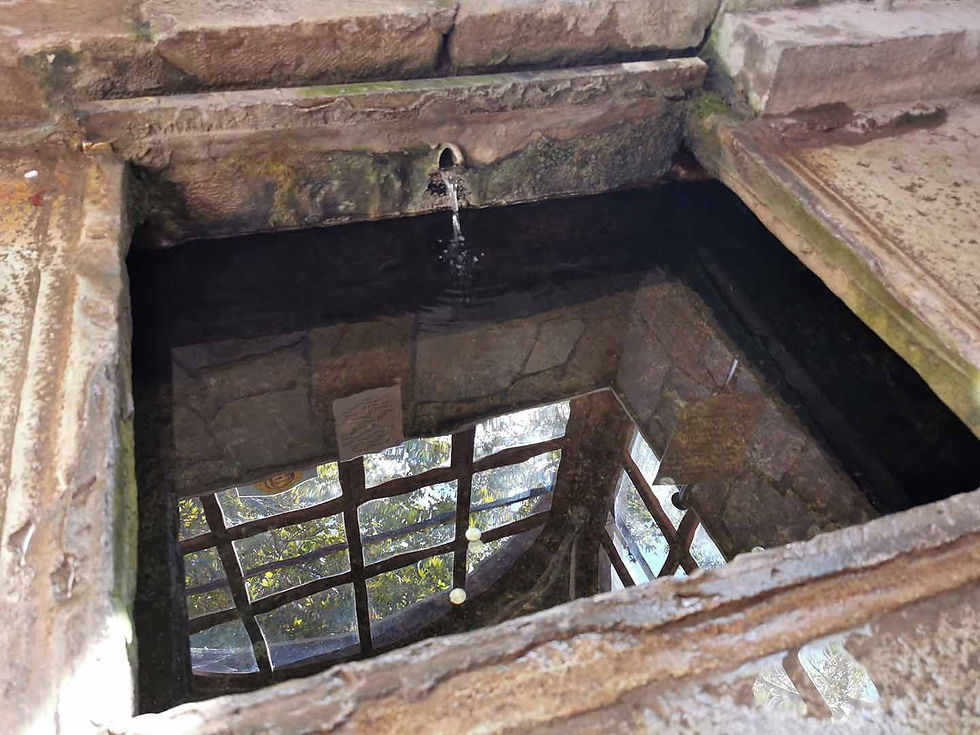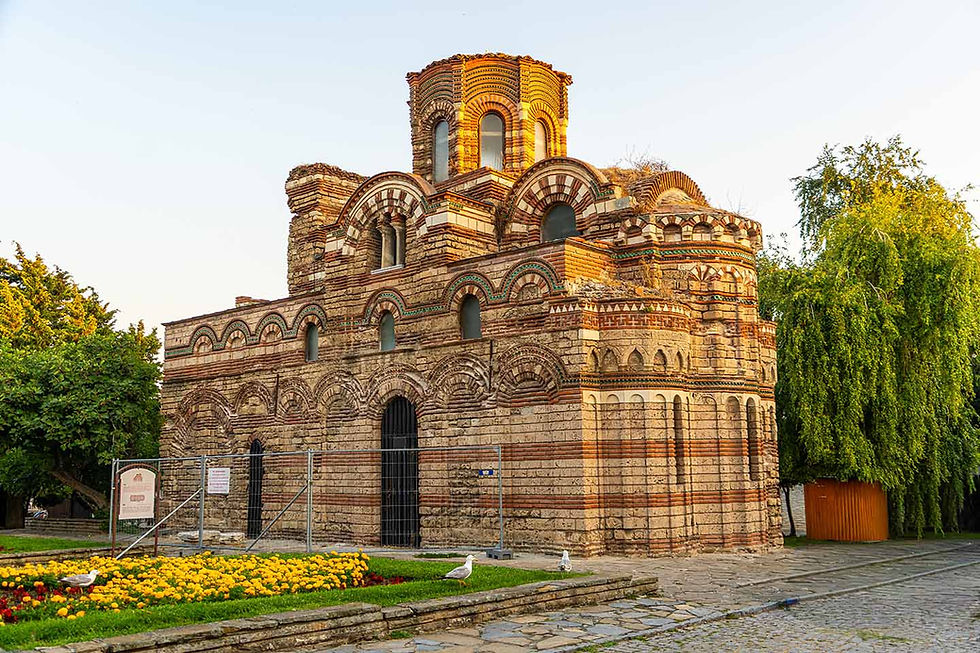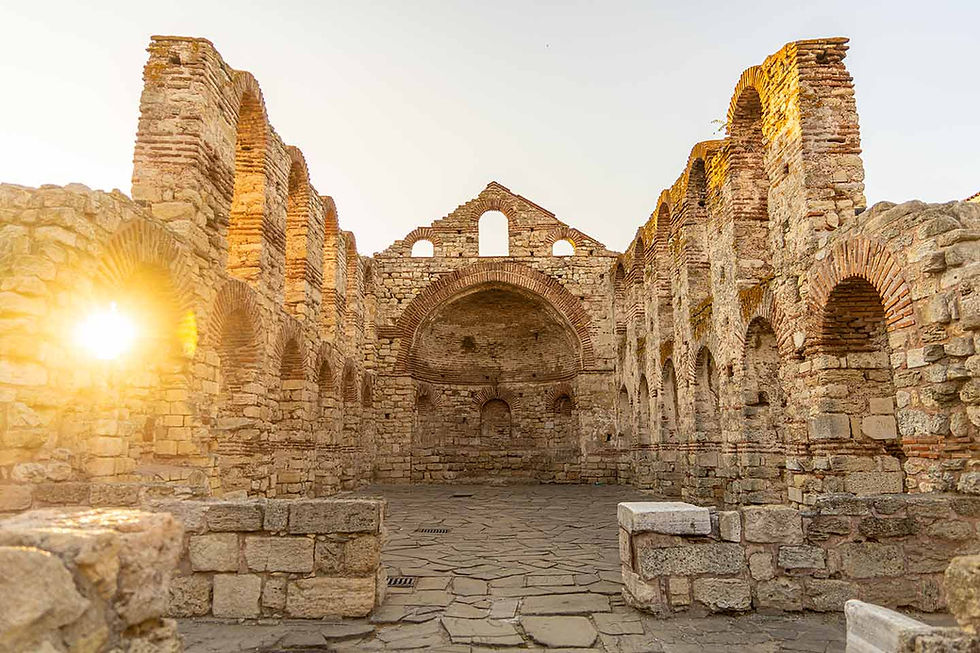Arapovo Monastery "Holy Martyr Nedelya"
- Stefan Ivanov

- Sep 25, 2022
- 7 min read
Updated: Jul 23
Among all Bulgarian monasteries, always hidden in the most beautiful and secret mountain folds, the Arapovo Monastery "Holy Martyr Nedelya" makes an exception and stands out with its unusual location.

It is built on the hilly plain at the foot of the Rhodope Mountains and no ridges, rocks, or forests hide it from view.

Just in front of its entrance, a bunch of huge trees with magnificent crowns magnificently enhances its special appearance and its specific romanticism.

The monastery is located 8 kilometers east of Asenovgrad near the village of Zlatovrah - with an old name of Arapovo, which comes from the name of the local Turkish feudal lord Arap Aga.

Arapovo Monastery was founded in 1856 near the spring that gushed out at this place.

A monastic dormitory was established near the spring, and the construction of the monastery complex lasted several years and was completed in 1859.

Archimandrite Sophrony, abbot of the nearby Moldava Monastery "St. Petka", made a particularly great contribution to this God-pleasing work.

The chief master of the monastery's construction was Usta Stoyu (Stoyan) Buradzhiyski (1832 – 1892) from the Rhodope village of Yugovo, Asenovgrad region.

At that time, Yugovo became the center of a remarkable construction school. A large group of craftsmen from Yugovo, as well as residents of the surrounding Bulgarian villages, took part in the construction of the monastery.

The Plovdiv Bulgarian Church Community, formed in the late 1850s during the Bulgarians' church-national struggle, played a major role in the creation and construction of the monastery.

Particularly zealous in the endeavor were prominent members of the Plovdiv municipality – Dr. Stoyan Chomakov, Pavel Kurtovich, Nikola Chaliki (Chalakov), Peyo Georgiev Kyurkchiyata, Stoil Zaraliata, Salcho Chomakov, Iskro Kesyakov.

The monastery church, dedicated to the Holy Great Martyr Nedelya, was built in 1859 and, according to the foundation inscription above the western entrance of the church, was the work of master Stoyu from Yugovo. The dimensions of the church are 23 x 12 meters.

The architectural plan and appearance of the church are of the Athonite type and are identical to those of the main temples in the Bachkovo and Gornovoden monasteries.

It is a three-nave, triconch-shaped temple with a dome. The walls are built entirely of carved white stone.

The dome of the church collapsed during the catastrophic earthquake of 1928. Soon after, it was rebuilt, but without restoring its old original architecture. The side entrances of the temple are decorated with representative canopied porticoes, crowned with gabled gables.
In 1867, a Bulgarian school was opened in the Arapovo Monastery. It was taught by prominent educational figures and participants in the national liberation movement, including Stoyan Dzhansazov, Archimandrite Damaskin Riley, Hierodeacon Vikenty, and Priest Sava Katrafilov.

According to the Constantinople newspaper "Macedonia", at that time 60 children from the surrounding villages and about 40 poor children from Plovdiv studied here.

During his tour of the Plovdiv diocese in 1872, Metropolitan Panarte – the first Bulgarian bishop appointed by the Bulgarian Exarchate – delivered a speech to the population of the village of Pranga (today Patriarch Evtimovo), in which he emphasized the great role of the Arapovo Monastery in preserving the Bulgarian language and faith in this region. Metropolitan Panarte pointed out that the monastery, with its remarkable educational activities, had a beneficial effect on the local population, which rejected pagan customs and superstitions. He advised his parishioners to listen more often to the new Renaissance intelligentsia, which had already grown up and could guarantee success for the spiritual and educational rise of the Bulgarian people. At the same time, patriotic lithographs were printed.

Arapovo Monastery "Holy Martyr Nedelya", although it emerged late in the Revival, occupies a significant place in all three main directions of the Revival process - New Bulgarian education, the struggle for church independence and the national liberation movement. One of the monastery monks, Hierodeacon Vikentii, was an active supporter of Vasil Levski in the creation of secret revolutionary committees. After his death, Atanas Uzunov appointed three revolutionary figures as his assistants to operate in the Plovdiv and Haskovo regions. These were priest Mincho Kanchev, priest Sava Katrafilov and Hierodeacon Vikentii. In the memoir book of priest Mincho Kanchev "Vidritsa" we find lines dedicated to Arapovo Monastery:
On May 10, 1873, on Thursday morning, we packed up, got on our horses and set off... Priest Mincho, deacon Vikentii and Nedyalko Neykov stopped by Chirpan, shopped and went to see Georgi Danchev...
We left Prangata (Patriarch Evtimovo) and here is the monastery. The dome shone and the sound of the bell spread down the river. The abbot with all his monastery clergy, teachers and students welcomed us as guests of the Holy Sepulchre and settled us in the rooms.
A second commemorative inscription from the monastery temple reports the assistance of Archimandrite Sophrony in the creation and initial construction of the monastery, who at that time was the abbot of the nearby Moldava Monastery "St. Petka". Later he was elected the first abbot of the newly established Arapovo Monastery. Above the northern and southern doors of the temple are inscribed the names of a number of donors from the surrounding settlements.

In 1859, a chapel with white stone masonry was built above the monastery spring, located about twenty meters from the northern side of the monastery. It was completely painted in 1870 again by the young Georgi Danchov.

The monastery buildings that have survived to this day have an original architecture, enhanced by the different number of floors in the individual parts, the external staircases and the verandas.

The residential buildings make a strange impression at first glance. They surround the courtyard, and those on the western side represent one of the rarest monastery complexes in our country. These buildings do not impress with the monumentality of the construction design, as we are used to seeing in other monasteries. Without the construction of lavish colonnades and impressive stone walls, here the individual buildings, touching each other, alternate with their unusual appearance, puzzling the viewer with their diversity and the inexhaustible imagination of their builders. The different levels of the roofs, the protruding bay windows, the various windows, the high verandas with colonnades, the facade planes grouped in no order, the stairs, the vaults, the bell tower, the chimneys and the turrets – all this apparent disorder is organized in unique harmony. The Renaissance master builders who built the monastery have left an architectural monument, incomparable in originality with any of the other monasteries.

The monastery also has two beautiful Renaissance fountains. One is in the courtyard, adjacent to the northern side of the Angel's Tower, and the other is outside, near the ancient trees at the western monastery gate. Its face is richly decorated with stone carvings. Cypresses and lions crowned with an elegant cross are depicted.
During the War of Independence in 1878, a large part of the monastery's buildings were burned down by the Bashibozuk, who were retreating with the Turkish army to Edirne, but soon after, the monastery was rebuilt. As a result of the catastrophic earthquake in Thrace in 1928, the monastery suffered significant damage again. Subsequent restoration work in the 1930s failed to restore its overall complex appearance. A large part of its library and the monastery archive were destroyed in these disasters.

In the courtyard of the monastery, which covers an area of 10 acres, stands a fortified three-story tower - pyrgo. The solid building, which inspires respect with its strict silhouette, was intended to provide refuge for the monastery's monks and continued resistance during the uncertain time of Turkish slavery.
I tell you about Angel's Tower and Angel the Commander HERE.
Life of the Holy Martyr Kyriakia – Sunday
The Holy Martyr Nedelya – Kyriakia was born in Asia Minor, probably in Nicodemus, the capital of the Roman Emperor Diocletian.
She was the child of the pious parents Dorotheus and Eusebia, who were prayed for with long prayers. From childhood she dedicated herself to God and decided to keep chastity all her life.
She grew up a beautiful and intelligent virgin. Many young men sought her consent to marriage, but she refused them all, saying that she was engaged to Christ and wanted to die a virgin. Then a young man from a noble family, offended by her refusal, informed Emperor Diocletian that the entire family of the girl Nedelya professed the Christian faith. The emperor exiled her parents to the city of Melitine, where they suffered martyrdom, and Nedelya was subjected to cruel torture. She was beaten with ox sinews, her whole body was lacerated, and she was burned with fire. However, everything was in vain.
They say that Christ appeared to the martyr in prison and healed her of her wounds. Finally, after Nedelya resolutely declared: For me, life is to die for Christ, the torturer sentenced her to be beheaded with a sword. At the place of her execution, Nedelya was allowed to pray before her death. After the prayer, she gave up her soul to the Lord without being beheaded.
They say that this happened on July 7, 289 AD.
The Bulgarian kings of the Asen family (12th - 13th centuries) transferred her relics to the capital of the Second Bulgarian Kingdom - Tarnovo.
Her life has been preserved in Old Bulgarian, written by Saint Euthymius, Patriarch of Tarnovo, who translated the name of the martyr from Greek to Bulgarian (Kyriaki - Nedelya). From that time to the present day, the custom of translating Greek names into Bulgarian has remained in Bulgaria.
How to get to Arapovo Monastery "Holy Martyr Nedelya"?
A wide dirt road leads to the monastery.
Arapovo Monastery "St. Martyr Nedelya" is located:
179 kilometers (about 2 hours and 11 minutes by car) from the capital
30 kilometers (about 38 minutes by car) from the city of Plovdiv
363 kilometers (about 4 hours and 20 minutes by car) from the city of Varna
241 kilometers (about 2 hours and 22 minutes by car) from the city of Burgas
The parking lot is extensive.
And finally, my dear friends,
you shouldn't miss checking out
the special photo album with moments –
discovered, experienced, filmed and shared with you!
















Comments